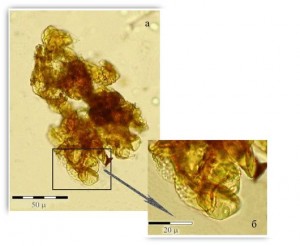Climate
The evolution of natural climate conditions on the Abrau Peninsula

97 samples of 9 sections were analyzed by palynological method. These sections were selected on the kourgan Rayevsky site of ancient settlement (two cuts) and Rayewski mound in the Dubki settlement-homestead (two cuts) that are at the foothills of the North-West Caucasus. A natural hole was explored in Tsemes grove and two cuts on Tsemdolina settlement, where the beginning of development of the territory had been associated with the Copper Age and lasted with few interruptions till the ancient time and including it. Therefore, the samples were analyzed in the section in the Myskhako settlement, located on the Black Sea coast in the Myskhako estuary. Here are better preserved deposits related to the formation of the Chalcolithic cultural layer, whereas the upper layer of ancient times had been largely destroyed.
As a result of palynological explorations on the archaeological sites of the Abrau peninsula using the data of the absolute dating of archaeological materials and taking into account the structural features of the studied strata and geomorphological conditions of the area, the first biostratigraphic scale for the region was made up. It gives the first representation of the features of environmental changes in the Abrau Peninsula, beginning with the Eneolithic, including the Bronze Age, antiquity and the Middle Ages. The most complete palynological characteristic was obtained for the Copper and the Bronze Ages.
Pollen studies allowed to identify the main stages of the environmental changes in the second half of the Copper Age to the end of the Atlantic period.

This time interval is characterized by the richest composition of flora, when grasses and forbs steppe was not the only element of the landscape. At that time, the peninsula still had a lot of forests, and their composition was diverse. Besides the oak, hornbeam, maple, hazel, birch and pine grew. In more humid habitat alder and less willow were common. At the very beginning of the Chalcolithic here grew silk tree and rhododendron ‒ relics of subtropical flora.
In open areas, apart from the meadow-steppe vegetation, there were arable lands, although their role in the landscape of the territory was small yet. Crops, according to the data of palynological analysis were wheat and possibly barley. The presence in samples of pollen of weeds, which often grow on the land, such as cornflower, Tatar buckwheat, knotweed and small form cruciferous indicates to the economic activities of the people in this area.
At the end of this period (about 5000 years ago) the forest area had decreased significantly. It was the time of great dryness of the climate, and the degradation of many settlements. Depending on the terrain, surrounding the villages, the nature of plant communities changed from the desert like steppes to the meadow-steppe groupings. At this time, there was not only a gradual change in the main types of vegetation in the landscape of the territory, but also reduction in the intensity of economic activities in the settlement, along with the reduction of the settlements themselves.
The Bronze Age in the explored territory is related to the sub-boreal period when environmental conditions changed from wet and cool to warm and dry and back to cooler.
In the first period of time meadow vegetation alternated with small oak groves, and at this stage they were the most. The peculiarities of the morphology of the pollen are found in several species of oaks, often pubescent oak (Quercus pubescens). This East sub-Mediterranean heliophilous species, which arewidely spreaded in southern Europe. It grows in the climate with distinct Mediterranean features (hot and dry summers and mild wet winters, the annuel average temperature of 9º‒12° C and precipitation of 420‒550 mm a year). The composition of copses of oak included hornbeam. While pine also was more widespread as now it is found only in the central and eastern parts of the North Caucasus.
Grasslands were widely developed with herbage of perennial grasses and they had gained large acreage, mainly engaged in cultural cereals.
Further, with increased cooling, fir and linden appeared in the forests, along with pine, oak and hornbeam. Some cooling snap could also help on increase in the role of the forest areas in the landscape of the territory.
Open spaces in addition to the natural meadow steppe communities had been occupied by agricultural land. Human presence in this period is seen by the presence of cultivated cereal pollen and a lot of pollen weeds of Cichorieae tribe.
During sub-boreal xerothermic period of time (the absolute age of 3810±130 years ago) in the explored area unfavorable conditions for the growth of not only trees, but also a variety of herbaceous vegetation had created. A characteristic feature of the vegetation is complete open landscape, even in the river valleys. At this time steppe vegetation dominated by drought-resistant steppe vegetation dominated there, the role of weeds increased closer to the settlements. Perhaps a part of the arable land was overgrown with weeds and plants of Cichorieae tribe. There were exactly representatives of this family which are often found in the abandoned arable land.
At the next stage (the absolute age is 3100 ± 130 years ago) with increased moisture steppe groupings where there were more mesophilic species of the legume family, clove and buttercup gradually revived. The proportion of Cichorieae tribe reduced and the role of grains, including cultural increased. Climate moistening of shows not only a change in the composition of herbaceous plants, but also the emergence of new kinds among tree species such as spruce and willow. It is possible that these plants did not grow at that time in that area, but their distribution ranges had moved to a lower level of vertical belts. There were also small areas of pine groves with oak, lime, and with the appearance of a single birch and alder.
Thereby, the materials which were obtained in the examined monuments, they managed to trace changes in vegetation throughout most of the Bronze Age. The landscape changed from the meadow-steppe groupings involving small arrays of the forest to steppes of different composition and again to the restoration on small areas of the forest, at the same time with steppe vegetation.
The antique period is represented in almost all the examined archaeological sites. However, the safety and sometimes the severity of the section of cultural layers was bad. The most complete changes in the environment they were able to trace the materials received in the Rayevsky and the Dubki settlements.
The basic conclusions about the dynamics of the climate and vegetation during the 3th‒1th century BC and 1‒2th century AD had been made exactly on these monuments.
The first explored stage of the ancient time took place at the beginning of early Subatlantic cooling, which began 2500 years ago. The climate at the time was wet and cool. Prevailing open landscapes were occupied by meadow-steppe and forest groves have been formed by a small pine participation with oak and spruce.
Later stages of the ancient time, starting with the 3th century BC, are characterized by more favorable climatic conditions. At that time in the woods oak and hornbeam and hazel appear, but pine became smaller. Open space is still occupied by meadow-steppes, their composition actually had not changed. The role of agricultural land over the whole region, compared with earlier eras had increased.
(E. A. Spiridonova; A. Aleshinskaya; M. Kochanova)
